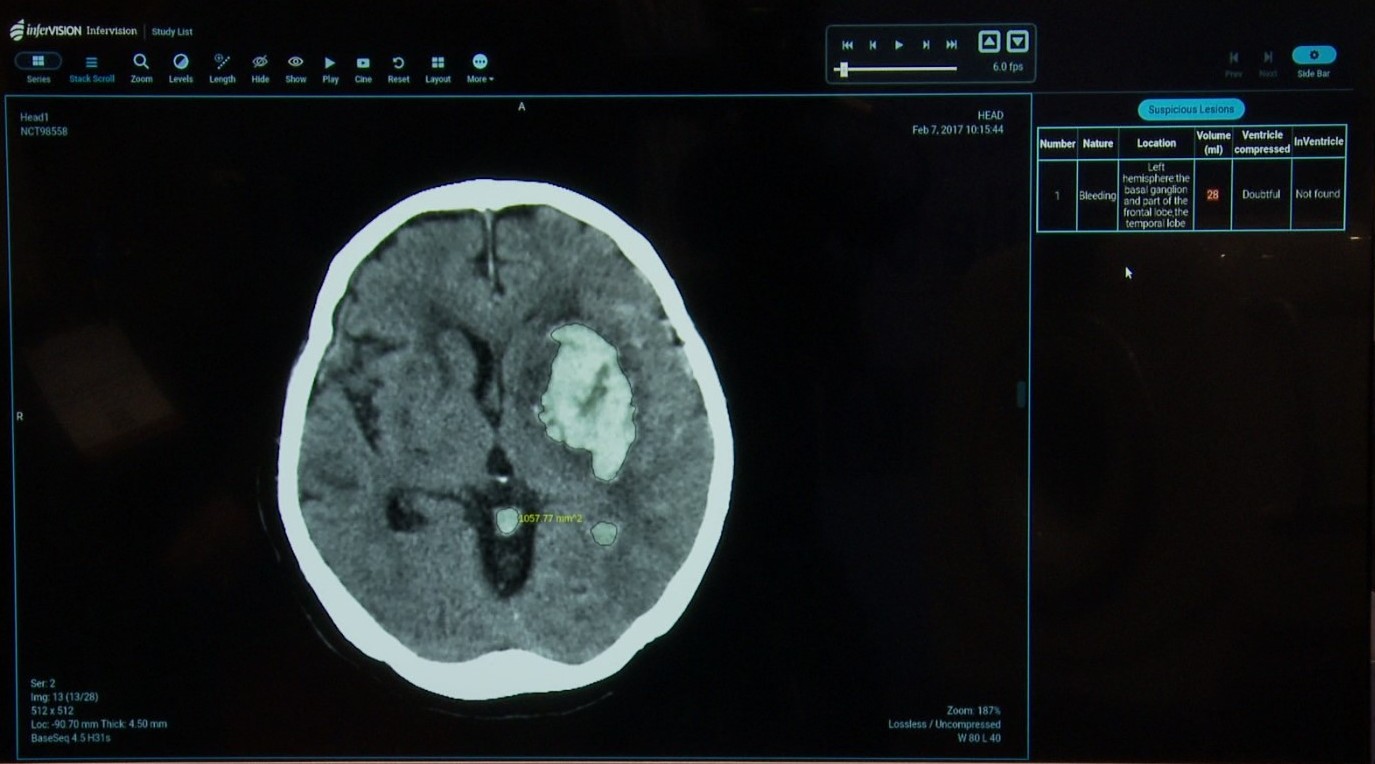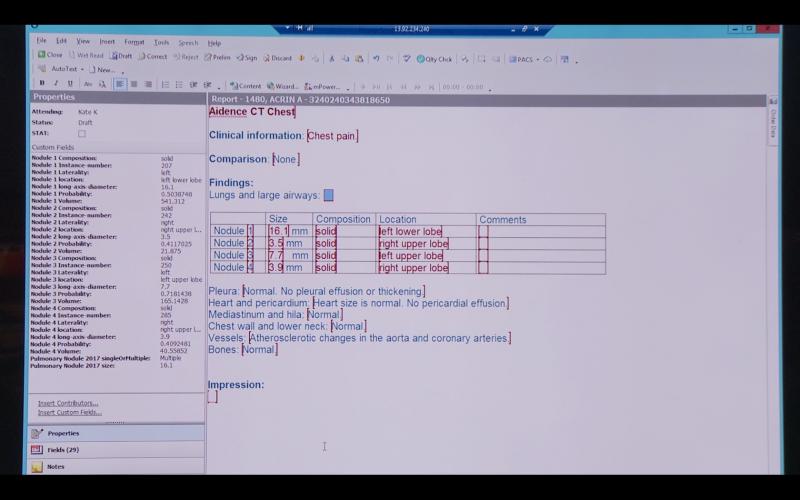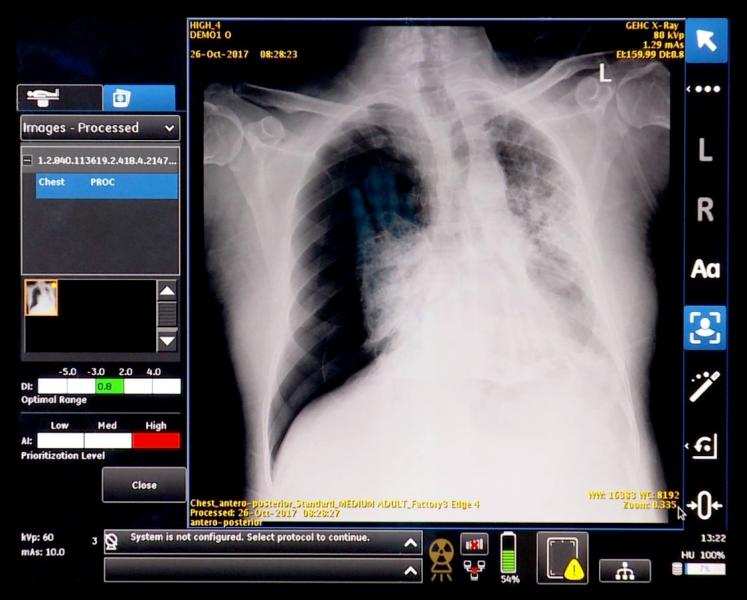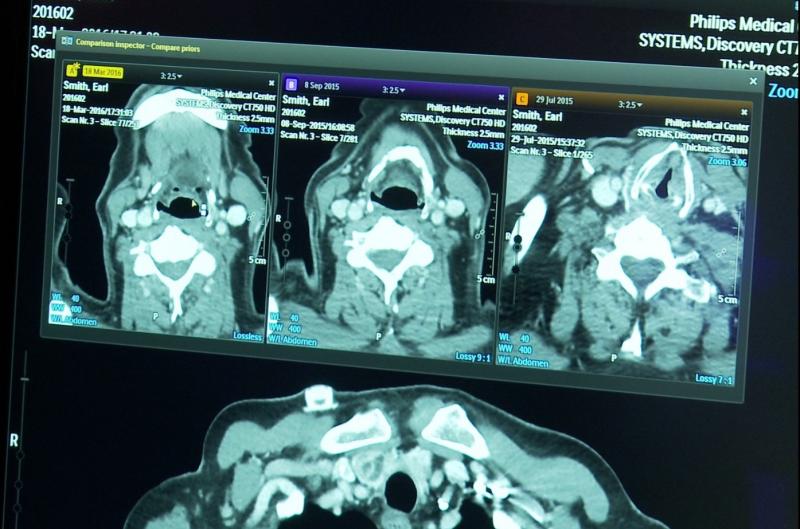
Exhibitors at the 2017 Radiological Society of North America (RSNA) meeting rode the artificial intelligence (AI) bandwagon as never before. Large companies and startups, veteran exhibitors and first timers showed AI, peeking out from the black boxes of products, works-in-progress and research.
In each, the stated purpose was the automation of time-consuming or difficult tasks, and improved efficiency and effectiveness to benefit patients (and providers). But it was the flash and glitz that captivated, however vendors were careful to tie the potential of smart algorithms to their use by people.
“Building AI around people, around their contextual setting, is really the way we are approaching it,” said Sham Sokka, Philips general manager of radiology solutions. “You wouldn’t have AI if you don’t have people performing a task.”
From one vendor to the next, AI was presented as an intelligent assistant, not a replacement for radiologists. “We are here to help radiologists,” said Tom Valent, vice president of business development at the Israeli startup Aidoc. “We want to make their jobs more efficient and let them focus on what really matters to diagnostics.”
AI should not — nor will it — threaten radiologists anytime soon, agreed every vendor interviewed on the RSNA exhibit floor. Clearly fear mongering was not what they wanted to do.
Their statements sharply contrasted the dire predictions of visionaries like Elon Musk (founder of Tesla and SpaceX) who on Aug. 11 tweeted: “If you're not concerned about AI safety, you should be. Vastly more risk than North Korea.”
Gratitude Over Fear
At RSNA 2017, radiology vendors wanted to replace fear with respect, even gratitude. Major vendors said they want to leverage intelligence to improve overall performance. Streamlining processes, as Philips’ Illumeo does, might free radiologists and staff from at least some tedious and humdrum tasks.
Maybe doing so will improve accuracy, maybe increase productivity, maybe both, Sokka said. The end result could be quicker decisions made with greater confidence. And because smart algorithms learn over time, they should get better at what they do, leading to even greater speed and more confidence in the future.
“You want to have the optimal set of tools to help improve your efficiency, as you’re going through a case,” said Kevin Lev, Philips Illumeo marketing lead, during an on-camera demonstration of Philips’ Illumeo featured during ITN's "VIDEO: Technology Report — Artificial Intelligence at RSNA 2017."
Philips’ application of adaptive intelligence is just beginning, Lev told ITN. “We would like to (develop) a platform that includes a lot of different technologies and solutions and integrate them throughout the different care pathways,” he said. “You have to look at all the operators — all the support staff – and their day to day tasks.”
Achieving this potential depends on creating an environment in which artificial and natural intelligence work together. In value-based medicine, that goal is increased efficiency, lower costs and improved care.
Jumping On The AI Bandwagon
From the pervasive talk by vendors about how AI can help radiology, you might think vendors had been talking it up for a long time. But 12 months earlier, AI barely registered on the exhibit floor radar. One blip came from Philips, which in 2016 introduced “adaptive intelligence” as the power behind its Illumeo platform.
Illumeo, which reappeared at this year’s RSNA, analyzes the context in which the radiologist is working. The AI suggests tools to assist the radiologist, such as measurement tools to analyze blood vessels.
The AI-based platform, according to Philips, can also gather information from the electronic medical record – laboratory and radiology reports, imaging orders, even scanned documents like handwritten referral letters from referring physicians.
Philips held out the hope that Illumeo’s ability to learn what radiologists want or need can streamline workflow. Lev explained that the technology can adapt to and remember radiologists’ preferences for hanging protocols.
And Illumeo can improve radiology in other ways, standardizing care throughout an institution, for example, by reminding radiologists and staff of best practices and established guidelines. It can also help generate radiology reports and make use of the information they contain.
Philips was accompanied by other vendors on similar missions. Nuance Communications demonstrated smart algorithms that can extract unstructured information from the narrative of radiology reports. Dictated typically in free form, these narratives, “go up to the electronic health record as a blob,” said Peter Durlach, Nuance senior vice president of strategy and new business development. “And you have no idea of whether follow-up recommendations are tracked and executed.”
Nuance is grooming AI to follow up on those recommendations. The company is also developing advanced search capabilities, combining them with traditional Boolean logic to help in the analysis of radiology reports.
At RSNA 2017, GE showed how integrating a smart algorithm with imaging technology might protect patient and provider. The company demonstrated a work in progress that combined a smart algorithm and a portable X-ray unit. Developed in concert with the University of California in San Francisco, the algorithm is designed to look for signs of pneumothorax (collapsed lung) in the chest radiographs of surgical patients before they exit the operating room.
“There is a huge financial benefit if you don’t have to incur a massive cost because of a collapsed lung,” said Keith Bigelow, general manager of analytics at GE Healthcare. “And, if you catch it before it becomes an emergency, operationally you’re not consuming that room for an emergency procedure.”
The algorithm might be adapted for other purposes, Bigelow noted, for example, to check for proper placement of a chest tube. GE is working on it, he said.
AI – AKA…
At RSNA 2017, GE Healthcare called AI “applied intelligence.” Agfa and IBM called it “augmented intelligence.” Each maintains the same acronym.
Doing so may have been designed to take the snarl out of artificial intelligence – much like magnetic resonance imaging dropped “nuclear” to keep from being associated with nuclear energy and the Three Mile Island accident of 1979. Or it may have been designed to brand AI as proprietary, much like Sterling Diagnostic did decades ago by trying to associate the DR acronym with its own “Direct Radiography” technology.
The stated goal of developing AI, however, was consistent among vendors – to build intelligence into clinical workflows in ways that might increase efficiency, boost productivity, and reduce variance in patient care. The use of artificially intelligent tools might “accelerate overall throughput and screen for critical diseases,” Agfa stated. This might be achieved, according to the company, through the use of AI-based tools that automate workflow, analyze large volumes of data, and assist in the production of radiology and other clinical reports.
At RSNA 2017, Agfa showed how smart algorithms might one day be integrated with its enterprise imaging platform to screen for cancer, tuberculosis and other life-threatening diseases. Siemens Healthineers took a decidedly nearer-term approach.
Its FAST (Fully Assisting Scanner Technologies) 3-D camera, shown as a work-in-progress pending FDA clearance, uses smart algorithms that analyze optical and infrared images of patients before they enter CT gantries. The ultimate goal behind the technology is to streamline workflow through optimal patient positioning. Siemens plans to release the FAST camera as an upgrade for its premium CT products.
The FAST 3D camera is only one of many such technologies Siemens is developing, according to Ragavan Dhandapany, vice president, marketing, sales operations and communications, diagnostic imaging, Siemens Healthineers. "Probably we have the largest amount of (AI) patents among large imaging players.”
Myriad Possibilities for AI
Siemens hopes to leverage AI to detect prostate cancer in MRI scans. The company is leveraging AI to examine images of differing contrasts and properties, such as morphology, cell density or physiological function. Artificial intelligence would then correlate findings with expert radiologist’s reports, while considering clinical data, for example, from biopsy results.
And AI might be used at the scanner level as well, screening images as the data are acquired, alerting radiologists to possible conditions that urgently require their attention, for example, intracranial bleeds.
Chinese startup Infervision is developing AI to analyze brain and lung images. One application would calculate the “bleed” volumes in the brain. Its calculations would be used to triage patients according to the urgency with which they require treatment. The other application is designed to help diagnosticians spot early signs of lung cancer.
In contrast to the specific objectives of Infervision products, Israeli startup Aidoc Medical is building algorithms to distinguish between abnormal and normal images. Its analyses would be used to prioritize cases according to the likelihood of disease.
“We have created an architecture that captures a wide array of different types of pathology that would be of interest to the radiologist,” said Tom Valent, Aidoc vice president of business development. “By doing that, we believe we can really improve the workflow — not by cherry picking a few pathologies, but by giving a wide perspective.”
Valent said analyses using Aidoc algorithms will give radiologists a “preview” of images that urgently require interpretation. “Our AI highlights the abnormal cases and, by doing that, we enable the radiologist to prioritize the cases and to read those cases earlier than he would otherwise.”
On an even more basic level, AI might be used to set “hanging protocols.” These protocols got their names from technologists hanging films on light boards the ways radiologists wanted to see them. Since the 1980s, PACS hanging protocols have been set using certain rules. GE’s Smart Reading Protocols (SRP) might take that a step further, applying smart algorithms that “learn” radiologists’ preferences and improve their performance over time.
SRPs might even launch the analytic tools radiologists would want to help in their interpretations. In this way, the algorithms would act like radiological equivalents of OR nurses who know the surgeons and procedures so well that they are ready to hand surgical instruments to them before being told to do so.
GE is also developing what it calls Imaging Related Clinical Context (IRCC) to enhance image interpretation done using GE’s Centricity PACS. The smart algorithms based on IRCC, which is being developed in partnership with the University of Pittsburgh Medical Center, could be delivering pathology reports or surgical and clinical notes relevant to the interpretation of patient images as early as this year.
Partnerships are common in AI R&D – and becoming more so. At RSNA 2017, Change Healthcare announced it was partnering with the Israeli startup Zebra Medical Vision to create AI-based solutions for its customers. Change, a major provider of health IT products following its merger in mid-2017 with McKesson Technology Solutions, hopes to integrate Zebra’s algorithms into radiologists' daily routine.
“Leveraging intelligence in the workflow enables the radiologist to make better use of the system,” said Ashish Sant, Change Healthcare senior vice president and general manager of radiology and infrastructure. “The system may be smart enough to get them what they need. Or maybe (the system provides) smarter hanging protocols or smarter alignment of information.”
Zebra’s “All in One” (AI1) application, which the company offers to providers for $1 per scan, looks for signs of lung, breast, liver, cardiovascular and bone disease. Sant described A1A and other Zebra’s AI-based technologies as representing a strategic fit for the company.
Involved in a similarly strategic partnership is California-based Arterys, which supplies GE Healthcare with smart algorithms to assess cardiac MR images. The algorithms help physicians make cardiac diagnoses in as little as 15 seconds. Without the help of such algorithms, these same diagnoses might take as long as 30 minutes, according to the company.
Reflecting the significance of AI, and the contribution that small companies can make, is the extraordinary financial support investors have showered on newly founded companies. From January to mid-November 2017, about $122 million was invested in such startups, according to the market analysis firm Signify Research. About two-thirds (64.5 percent) of this funding has gone to companies based in Asia. Most are Chinese, which is “not overly surprising given the chronic shortage of skilled medical professionals in China,” according to Signify. The wide availability of large imaging data sets to train the algorithms is another factor, according to the research firm.
Three of the top five beneficiaries are Chinese. Infervision ranked second, having raised funds totaling $18 million in 2017 and more than $27 million since its founding.
Artificial Versus Natural Intelligence
Regardless of how artificial intelligence is applied, the underlying intelligence is undeniably artificial. That fundamental truth has been enough to make some people fearful that artificially intelligent machines might one day replace humans. Vendors in radiology have sought to quiet those fears by positioning their AI creations as intelligent assistants that help people do their jobs faster and better.
The patient ultimately would benefit from these creations, say vendors, through better and more convenient health care.
Although artificial intelligence took a very high profile at this last RSNA, that may not be the case in years to come. The less obvious AI, the better, said Eran Rubens, Philips’ chief technology officer for radiology informatics.
“When we look at good applications of artificial intelligence, they are invisible,” said Rubens in an on-camera in interview included in ITN’s new video about AI. “They are contextually enhancing the user…enhancing your experience and augmenting your capabilities.”
One day, AI may not be recognized as the power behind these machines. If better healthcare can be delivered faster and at less cost, only the results will matter.
Related ITN Content on Artificial Intelligence
VIDEO: Technology Report — Artificial Intelligence at RSNA 2017
Key RSNA 2017 Study Presentations, Trends and Video
VIDEO "Deep Learning is Key Technology Trend at RSNA 2017"
VIDEO "How Utilization of Artificial Intelligence Will Impact Radiology" — an interview with Adam Flanders, M.D., chair of the RSNA Radiology Informatics Committee
VIDEO: Deep Learning is Key Technology Trend at RSNA 2017
VIDEO: Examples of How Artificial Intelligence Will Improve Medical Imaging
Value in Radiology Takes on Added Depth at RSNA 2017
VIDEO: Machine Learning and the Future of Radiology
VIDEO: Expanding Role for Artificial Intelligence in Medical Imaging





 April 17, 2024
April 17, 2024 








